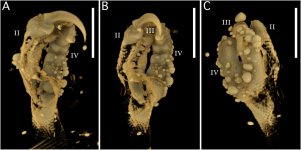Fred Ruhe
Well-known member

Alexander D. Clark & Jingmai O'Connor, 2021
Exploring the Ecomorphology of Two Cretaceous Enantiornithines With Unique Pedal Morphology
Frontiers in Ecology and Evolution. 9: Article 654156.
doi:10.3389/fevo.2021.654156
Abstract and full text: Exploring the Ecomorphology of Two Cretaceous Enantiornithines With Unique Pedal Morphology
Recently, ∼100 Ma amber from Myanmar has become an important source of information regarding the morphology of Late Cretaceous enantiornithines. Two specimens consisting of partial hindlimbs exhibit unusual morphologies when compared to both extant avian taxa and other Cretaceous enantiornithines. Pedal morphology is extremely ecologically informative in Aves as it represents the interface between body and substrate. These seemingly bizarre pedal morphologies represent adaptations that allowed these birds to utilize certain niches present in their paleoenvironment. Specific ecological niches apply the same general pressures to different species over time, and in doing so, through natural selection, produce morphologies that function much the same, although they may be anatomically dissimilar. As such, extant animals can provide useful information pertaining to the functional morphology of extinct animals, even in the absence of direct analogs, as in the case of these two Hukawng enantiornithines. Comparisons to extant taxa in the same predicted niches of these enantiornithines can be used to either support or contradict previous hypotheses regarding the in vivo function of these unique pedal morphologies. Elektorornis chenguangi exhibits a hypertrophied third pedal digit, originally interpreted as an appendage used for probing. We support this interpretation, which allows informed speculation as to the cranial anatomy of this taxon since extant animals that probe in woody substrates consistently pair elongate probing structures with a second robust structure that functions as a means to penetrate into this hard substrate. This suggests that the rostrum of Elektorornis would have been robust and most likely edentulous. The second specimen YLSNHM01001 exhibits an unusually mediolaterally robust fourth pedal digit, nearly double the width of digit II. Given that no such morphology is present in any other bird in the Mesozoic or Cenozoic we feel the unusual morphology justifies erection of a new taxon, Fortipesavis prehendens gen. et sp. nov. Although distinct, the morphology in F. prehendens resembles the syndactyl condition in some extant avian groups, and we hypothesize the robust digit similarly functioned to increase the surface area of the foot, facilitating grip on perches through increased friction. The necessity for increased grip and the lateral placement of this digit may suggest F. prehendens utilized mobile perches similar to extant kingfishers.
Enjoy,
Fred
Exploring the Ecomorphology of Two Cretaceous Enantiornithines With Unique Pedal Morphology
Frontiers in Ecology and Evolution. 9: Article 654156.
doi:10.3389/fevo.2021.654156
Abstract and full text: Exploring the Ecomorphology of Two Cretaceous Enantiornithines With Unique Pedal Morphology
Recently, ∼100 Ma amber from Myanmar has become an important source of information regarding the morphology of Late Cretaceous enantiornithines. Two specimens consisting of partial hindlimbs exhibit unusual morphologies when compared to both extant avian taxa and other Cretaceous enantiornithines. Pedal morphology is extremely ecologically informative in Aves as it represents the interface between body and substrate. These seemingly bizarre pedal morphologies represent adaptations that allowed these birds to utilize certain niches present in their paleoenvironment. Specific ecological niches apply the same general pressures to different species over time, and in doing so, through natural selection, produce morphologies that function much the same, although they may be anatomically dissimilar. As such, extant animals can provide useful information pertaining to the functional morphology of extinct animals, even in the absence of direct analogs, as in the case of these two Hukawng enantiornithines. Comparisons to extant taxa in the same predicted niches of these enantiornithines can be used to either support or contradict previous hypotheses regarding the in vivo function of these unique pedal morphologies. Elektorornis chenguangi exhibits a hypertrophied third pedal digit, originally interpreted as an appendage used for probing. We support this interpretation, which allows informed speculation as to the cranial anatomy of this taxon since extant animals that probe in woody substrates consistently pair elongate probing structures with a second robust structure that functions as a means to penetrate into this hard substrate. This suggests that the rostrum of Elektorornis would have been robust and most likely edentulous. The second specimen YLSNHM01001 exhibits an unusually mediolaterally robust fourth pedal digit, nearly double the width of digit II. Given that no such morphology is present in any other bird in the Mesozoic or Cenozoic we feel the unusual morphology justifies erection of a new taxon, Fortipesavis prehendens gen. et sp. nov. Although distinct, the morphology in F. prehendens resembles the syndactyl condition in some extant avian groups, and we hypothesize the robust digit similarly functioned to increase the surface area of the foot, facilitating grip on perches through increased friction. The necessity for increased grip and the lateral placement of this digit may suggest F. prehendens utilized mobile perches similar to extant kingfishers.
Enjoy,
Fred
Last edited:




